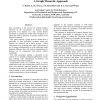Free Online Productivity Tools
i2Speak
i2Symbol
i2OCR
iTex2Img
iWeb2Print
iWeb2Shot
i2Type
iPdf2Split
iPdf2Merge
i2Bopomofo
i2Arabic
i2Style
i2Image
i2PDF
iLatex2Rtf
Sci2ools
ICRA
2000
IEEE
2000
IEEE
Data Association for Mobile Robot Navigation: A Graph Theoretic Approach
Data association is the process of relating features observed in the environment to features viewed previously or to features in a map. Correct feature association is essential for mobile robot navigation as it allows the robot to determine its location relative to the features it observes. This paper presents a graph theoretic method that is applicable to data association problems where the features are observed via a batch process. Batch observations (e.g., scanning laser, radar, video) detect a set of features simultaneously or with sufficiently small temporal difference that, with motion compensation, the features can be represented with precise relative coordinates. This data association method is described in the context of two possible navigation applications: metric map building with simultaneous localisation, and topological map based localisation. Experimental results are presented using an indoor mobile robot with a 2D scanning laser sensor. Given two scans from different u...
| Added | 31 Jul 2010 |
| Updated | 31 Jul 2010 |
| Type | Conference |
| Year | 2000 |
| Where | ICRA |
| Authors | Tim Bailey, Eduardo Mario Nebot, Julio Rosenblatt, Hugh F. Durrant-Whyte |
Comments (0)

